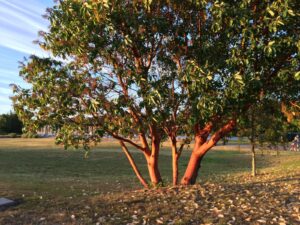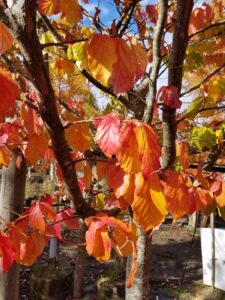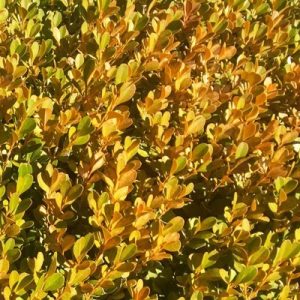Landscape Architect Tree Blog October 2021
During the dreary months of Winter 2020/2021, we tried something new at Puget Sound Plants. We created a campaign to reach out and start purposeful conversations with various Landscape Architects throughout Washington State. Over the course of 4 months, we had virtual meetings with over 30 organizations, 100 people, who love plants as much as we do. We heard repeatedly the difficulty of finding a diverse range of trees, and we expect this issue to persist for a few reasons. There is a shortage in the industry of local NW grown trees as family-owned nurseries fade away or get bought up by larger corporations less interested in our regional plants. We see a native conifer shortage due to the fact that most of our native conifers are not wanted outside of the Pacific Northwest. The vast majority of Oregon wholesale nurseries only grow plants with a national demand. Biodiversity amongst our natives came up multiple times. To address the need for more diversity in genetics, we are harvesting seed from throughout the region. We heard that LA’s and municipalities recognize the importance of diversifying the current tree selection by increasing the percentage of trees from multiple Genus, that is where this blog comes in to play.
With the acquisition of over 300 acres in Lewis County, we now have the space to venture out to try different trees that we never had room for in the past. Our land has wonderfully rich sandy soil, which broadens our selection of trees to grow. We had trialed multiple trees in the past with little success due to the more dense, clay soils at our Chehalis growing facility. Normally growing trees in sand soils is not feasible due the inability to ball and burlap a tree with that soil profile. Puget Sound Plants is unique in that we use grow bags. While grow bags burden us with additional costs and labor demands, the benefits are appreciated. These grow bags allow us to harvest year-round (with few exceptions), grow healthier plants, and grow in any type of soil. Puget Sound Plants only ships in Washington State so we only grow plants suited for this region. This means we can justify trying out some of the plants below that normally would never be planted in a large 500 acre wholesale nursery operation. We are excited to share a few examples of the trees we are currently experimenting with to help meet the needs of PNW LA’s.
 Cornus nuttallii – A broadleaf deciduous native tree which shows off bright white flowers in the Spring and orange to bright red fruit in the fall. This is not a hybrid, it is all regional genetics. The initial staking in this photo is to make sure they are at least going upright. After this, they will not be staked or pruned in order to have a natural shape. We will put them into 18” grow bags with a goal size of about 2” or 8-10’ depending on how they grow. We anticipate an ETA for sellable Cornus nuttallii to be ready sometime in 2024/2025.
Cornus nuttallii – A broadleaf deciduous native tree which shows off bright white flowers in the Spring and orange to bright red fruit in the fall. This is not a hybrid, it is all regional genetics. The initial staking in this photo is to make sure they are at least going upright. After this, they will not be staked or pruned in order to have a natural shape. We will put them into 18” grow bags with a goal size of about 2” or 8-10’ depending on how they grow. We anticipate an ETA for sellable Cornus nuttallii to be ready sometime in 2024/2025. 
 Quercus garryana – While we already have these natives in our selection, we will be adding a natural form to the existing street tree form. They will be upright but mostly left to grow how they wish, so with some added character! We anticipate a ready date of 2024/2025. We hope to have photos in a follow up post next year.
Quercus garryana – While we already have these natives in our selection, we will be adding a natural form to the existing street tree form. They will be upright but mostly left to grow how they wish, so with some added character! We anticipate a ready date of 2024/2025. We hope to have photos in a follow up post next year. Zelkova serrata – This low maintenance shade tree will be seed grown. While not Native, it is typically noted for attractive bark, clean foliage, and resistance to Dutch elm disease. Our trees will have a much more natural form versus the cultivars on the market currently that are very uniform and have their branching tightly spaced. This is will give another option for a large tree other than Quercus and Ulmus that already dominate the area. We look forward to a ready date of 2023/2024.
Fagus grandiflora – While native to eastern North America, this sturdy large deciduous tree will be seed grown. Dirr in Manual of Woody Landscape Plants “a beech is planted for posterity and my children and yours will enjoy its grandeur”, he continues to write on this species being used over Fagus sylvatica. We plan to offer this tree in 2023/2024 as another option for a large tree other than Quercus and Ulmus that dominate in the area.
 Cercis occidentalis – This small deciduous plant with shiny heart-shaped leaves will be grown as a natural form shrub. They will be planted in a sandy field in a 14” bag. Our target size is a 4-5’ shrub if they are thick and bushy, or 5-7’ if they are more upright and gain good height. We plan to offer these on our availability lists sometime in 2023/2024.
Cercis occidentalis – This small deciduous plant with shiny heart-shaped leaves will be grown as a natural form shrub. They will be planted in a sandy field in a 14” bag. Our target size is a 4-5’ shrub if they are thick and bushy, or 5-7’ if they are more upright and gain good height. We plan to offer these on our availability lists sometime in 2023/2024. Pistacia chinensis – We see this as an option for those “bad” sites that not much else will appreciate. A midsize deciduous with Fall color we can appreciate, typically tolerates light shade, heat, and a wide range of soils. We look forward to these being available in 2025/2026.
Rhamnus pershiana – 23/24. This excellent Native which is often found in shrub form, actually takes well to being made into a tree form. Fall color depends on sun exposure and can vary from pure yellow, to yellow mixed with orange, red, and purple. In heavier soils they can have issues at the soil level that make a tree form harder to establish but our new sandy soils should grow excellent Rhamnus.
We are so excited to expand our tree selection and look forward to sharing a progress report in the future. As always, we love to hear from municipalities and landscape architects! You play a big part in what we grow, and we need your input if you want something different. Thanks for reading, and until next time, be well.
CATEGORIES
————————
RECENT POST

What’s New With Trees Blog October 2021
During the dreary months of Winter 2020/2021, we tried something new at Puget Sound Plants. We created a campaign to reach out and start purposeful conversations with various Landscape Architects throughout Washington State.

Boxwood Bronzing
Boxwood Bronzing As we come out of the winter I wanted to talk about everyone’s favorite hedge plant, boxwood.The english boxwood, Buxus sempervirens, along with

Leafspot Part 2
Leafspot Part 2 Last month I talked to you about fungal leafspot, now we’re onto the harder of the two, bacterial leafspot. Bacterial leafspot is

